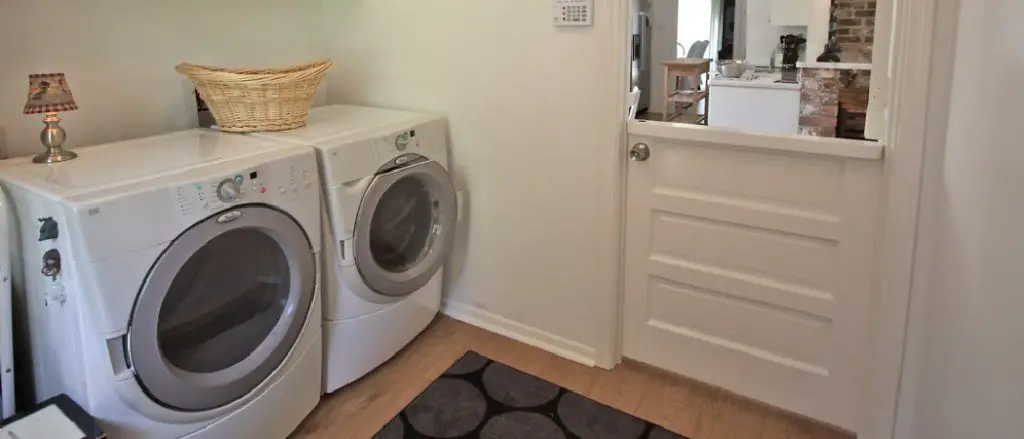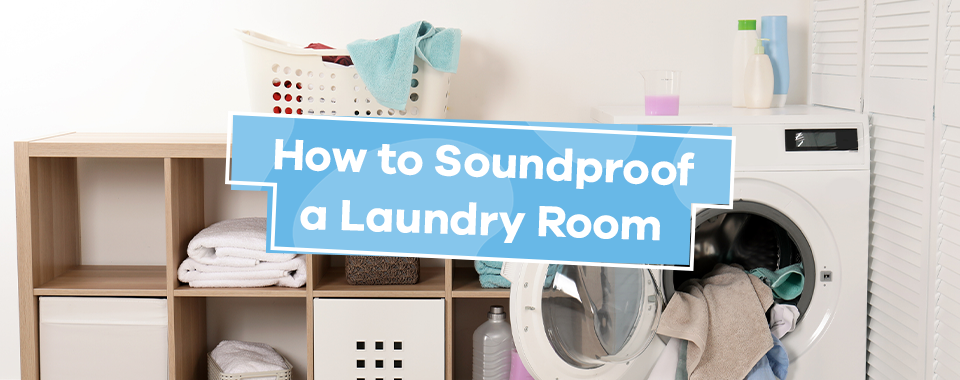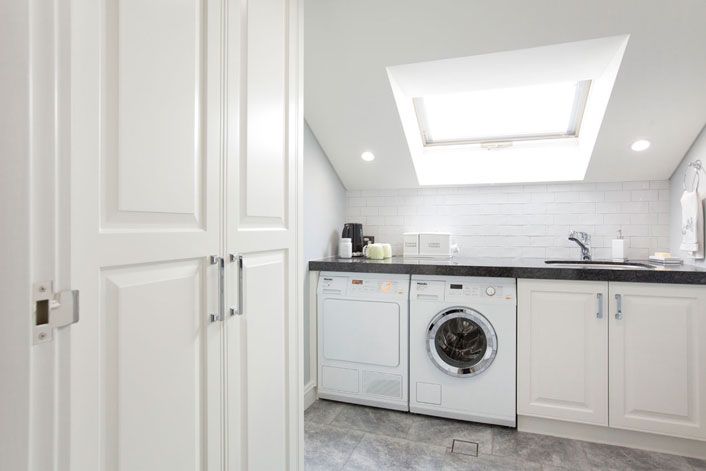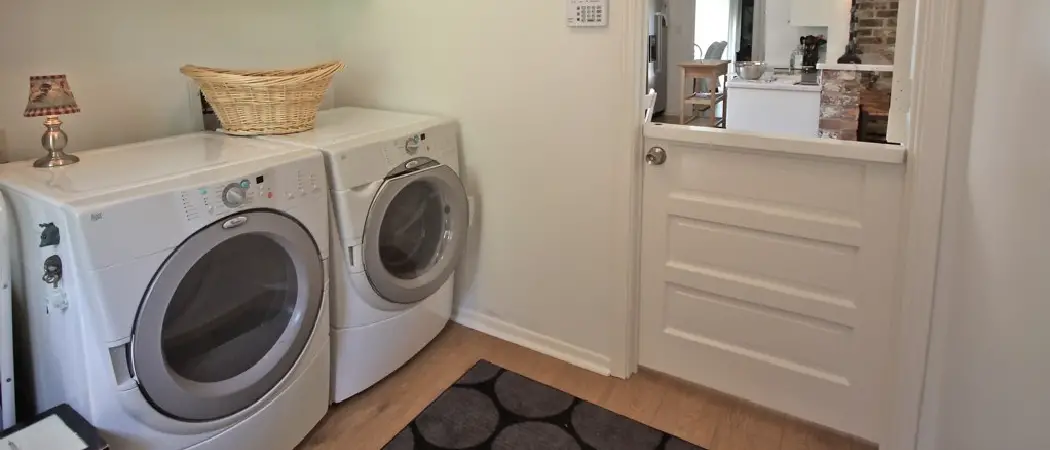To soundproof the laundry room, install sound-absorbing materials on walls and floors for noise reduction. Consider adding weatherstripping to doors for extra insulation.
Creating a quiet laundry room environment is essential for minimizing noise disturbance in your home. By implementing soundproofing techniques, you can prevent the noise generated by the washing machine and dryer from traveling to other areas of the house. From installing acoustic panels to sealing gaps and cracks, there are various effective ways to soundproof your laundry room.
In this guide, we will explore practical tips and solutions to help you achieve a quieter and more peaceful laundry space. Let’s dive into how you can soundproof your laundry room effectively and efficiently.

1. Assessing The Noise Source
To soundproof the laundry room, start by pinpointing the noise source before making any changes. Assessing the source helps in determining the best soundproofing solutions for a quieter laundry space. Identifying the noise culprit is the first step towards creating a more peaceful environment for laundry tasks.
The first step in soundproofing your laundry room is to assess the noise source. By identifying the primary noise sources and determining the level of noise transmission, you can effectively address the issue and create a more peaceful laundry environment.
1.1 Identify The Primary Noise Sources
To begin, let’s identify the primary noise sources in your laundry room. This will help you understand what aspects of your laundry room are contributing to the noise problem. Here are some common noise sources you should consider:
- The washing machine
- The dryer
- Vibrations from the machines
- Noisy pipes or plumbing
- Noise from the ventilation system
By pinpointing these sources, you can focus on finding solutions that directly address each one and effectively reduce the overall noise level.
1.2 Determine The Level Of Noise Transmission
Once you have identified the primary noise sources, it’s important to determine the level of noise transmission in your laundry room. This will help you understand how the noise is traveling and what measures you need to take to soundproof the space effectively.
There are a few factors to consider when assessing the level of noise transmission:
- The thickness and material of your walls
- The type of flooring in your laundry room
- The presence of any gaps or cracks where sound might escape
By evaluating these factors, you can gain a better understanding of how sound is traveling and identify potential areas for improvement.
Remember, a comprehensive assessment of the noise source is crucial in determining the best soundproofing strategies for your laundry room. By targeting the specific noise sources and understanding the level of noise transmission, you can create a more peaceful and enjoyable laundry experience.
2. Soundproofing Walls
When soundproofing your laundry room, it’s crucial to focus on the walls as they are the main source of noise transmission. Here’s how you can effectively soundproof your walls:
2.1 Insulate The Walls With Soundproof Materials
- Use acoustic foam panels or soundproof curtains to absorb sound waves.
- Install resilient channels to create an air gap between the wall and drywall.
- Consider adding soundproofing batt insulation to block out noise.
2.2 Seal Any Gaps Or Cracks In The Walls
- Apply acoustical caulk around electrical outlets, windows, and doors.
- Use weather-stripping tape to seal gaps between the wall and the door frame.
- Ensure there are no openings for sound to travel through.
3. Soundproofing Doors
Soundproofing the doors in your laundry room is essential for reducing noise transmission. Here are two effective ways to soundproof your laundry room doors:
3.1 Install A Solid-core Door
Replacing your standard hollow-core door with a solid-core door can significantly reduce sound transmission. Solid-core doors are denser and provide better insulation against sound waves.
3.2 Add Door Sweeps Or Weatherstripping
Door sweeps and weatherstripping are affordable solutions that can help seal the gaps around the door, preventing noise from leaking out of the laundry room. These materials create a tight seal when the door is closed, effectively reducing sound transmission.

Credit: www.soundproofcow.com
4. Soundproofing Windows
When it comes to soundproofing windows in your laundry room, there are several effective strategies to reduce noise transmission. Properly soundproofing windows can significantly minimize the amount of noise that enters or exits the laundry room, creating a quieter and more comfortable environment. By implementing these soundproofing techniques, you can enhance the overall acoustics of your laundry room and minimize disturbances caused by noisy appliances.
4.1 Use Double-pane Windows
Installing double-pane windows is an efficient method to minimize noise infiltration in the laundry room. These windows consist of two glass panes separated by a layer of insulating gas, creating a barrier that reduces sound transmission. The air space between the panes helps minimize sound waves, effectively dampening noise from outside and reducing vibrations from the washing machine or dryer.
4.2 Apply Soundproof Film Or Curtains
Applying soundproof film or curtains can further enhance the soundproofing of windows in the laundry room. Soundproof window films act as a barrier to block outside noise, while curtains with sound-absorbing properties help dampen sound within the room. These solutions are cost-effective and easy to install, offering an additional layer of sound insulation to create a more peaceful laundry environment.
5. Soundproofing The Floor
Soundproofing the floor of your laundry room is a crucial step in creating a peaceful and quiet space. A noisy floor can transmit vibrations and impact noise, disrupting the tranquility of your home. Let’s explore two effective methods to soundproof the laundry room floor:
5.1 Use Sound-absorbing Floor Mats Or Rugs
Sound-absorbing floor mats or rugs can significantly reduce impact noise and muffle vibrations from laundry machines. These mats are typically made of dense materials like rubber or foam, which effectively dampen sound. You can place them directly underneath the washing machine and dryer to minimize noise transmission. These mats are also easy to install and can be found in various sizes to accommodate your specific laundry room dimensions.
5.2 Install Acoustic Underlayment
Acoustic underlayment serves as an additional layer of sound insulation between the existing floor and the new flooring material. When installed beneath the flooring, it effectively absorbs impact noise and minimizes the transmission of sound. The underlayment material can range from cork to rubber to specialized foams, each with its unique sound-dampening properties. It’s important to choose an underlayment designed specifically for soundproofing to achieve optimal results.
6. Soundproofing The Ventilation System
The ventilation system in your laundry room can be a major source of noise. Soundproofing it can help create a quieter and more peaceful environment. There are various soundproofing techniques you can implement to effectively reduce the noise coming from the ventilation system, ensuring a more pleasant laundry experience.
Soundproofing the ventilation system in your laundry room is crucial to minimize noise transmission and ensure a peaceful environment. By implementing specific techniques, you can effectively reduce noise generated by the ventilation system and make your laundry space more enjoyable. Here are two methods that can help you soundproof the ventilation system:
6.1 Use Soundproof Ducts Or Vents
Using soundproof ducts or vents is a practical solution to reduce noise in your laundry room. By replacing the standard ducts or vents with soundproof alternatives, you can limit sound transmission through the ventilation system. These soundproof ducts and vents usually feature specialized insulation materials or sound-absorbing properties, effectively dampening the noise before it reaches your ears.
6.2 Install A Noise-reducing Fan
Installing a noise-reducing fan is another effective way to soundproof your laundry room’s ventilation system. Opt for a fan specifically designed to minimize noise levels. These noise-reducing fans often come with features such as vibration dampening mounts, insulated blades, and advanced motor technology to reduce the overall noise generated. By replacing your current fan with a quieter alternative, you can enjoy a more tranquil laundry experience.
In conclusion, soundproofing the ventilation system in your laundry room is essential for creating a peaceful environment. Through the use of soundproof ducts or vents and noise-reducing fans, you can effectively reduce noise transmission and enjoy a quieter laundry space. Implementing these solutions will enhance your overall comfort and ensure a more pleasant laundry experience.
7. Minimizing Appliance Noise
Soundproofing the laundry room is essential for minimizing appliance noise. By insulating walls, adding weatherstripping to doors, and using anti-vibration pads under appliances, you can create a quieter and more peaceful space for your laundry tasks.
The noise generated by the appliances in your laundry room can be irritating, especially if your laundry room is located near living spaces or bedrooms. However, there are effective steps you can take to minimize appliance noise and create a more peaceful laundry experience.
7.1 Choose Quiet Appliances
When shopping for laundry appliances, opt for models that are designed to operate quietly. Look for washing machines and dryers that come with noise-reduction features or have been specially engineered to produce less noise during operation. Before making a purchase, check the product specifications and look for decibel (dB) ratings. Lower dB ratings indicate quieter operation.
7.2 Install Anti-vibration Pads For Machines
Installing anti-vibration pads under your washing machine and dryer can significantly reduce the noise and vibrations produced during laundry cycles. These pads help dampen the vibrations that are generated when the machines are in use, preventing them from transferring to the floor and surrounding surfaces. By absorbing the vibrations, these pads also minimize the noise caused by the machines moving or shaking.
Consider using anti-vibration pads made of materials like rubber or neoprene. These pads effectively absorb vibrations and are easy to install. Simply place them under each corner of the appliance and ensure they are securely in position. Anti-vibration pads are readily available online or at home improvement stores.
By choosing quiet appliances and installing anti-vibration pads, you can minimize the noise produced by your laundry room appliances and make your laundry experience much more pleasant and peaceful. Take the necessary steps to soundproof your laundry room and enjoy a quieter space with minimal disruption.

Credit: residential-acoustics.com
8. Additional Noise Reduction Techniques
Implementing additional noise reduction techniques can greatly improve soundproofing in the laundry room. These techniques include using acoustic caulk to seal gaps and cracks, installing soundproofing curtains or panels, and placing rubber mats under appliances to dampen vibrations. These simple yet effective methods can significantly reduce noise levels in the laundry area.
Making small adjustments such as adding additional noise reduction techniques can significantly enhance soundproofing in your laundry room. Here are some effective methods:
8.1 Use Soundproof Curtains Or Room Dividers
– Hang soundproof curtains around the room to block noise.
– Install room dividers made of noise-reducing materials.
8.2 Employ Sound-absorbing Panels Or Acoustic Foam
– Place sound-absorbing panels strategically on walls for better sound control.
– Use acoustic foam to minimize noise reverberation in the room.
By incorporating these techniques, you can create a quieter environment in your laundry room.
Frequently Asked Questions On How To Soundproof The Laundry Room
How Do You Muffle The Sound Of A Washing Machine?
To muffle the sound of a washing machine, place rubber padding or a soundproof mat underneath it. Tighten loose parts and ensure the machine is level. Consider a noise-reducing blanket or vibration pads for further noise reduction.
What Can I Put Under My Washing Machine To Stop Noise?
Place anti-vibration pads or a rubber mat beneath your washing machine to reduce noise.
How Do You Soundproof A Room Asap?
To soundproof a room ASAP, use weatherstripping on doors and windows, add heavy curtains or acoustic panels, cover floors with rugs or carpets, seal gaps in walls, and use soundproofing materials like acoustic foam or insulation.
How Do I Soundproof My Dryer?
To soundproof your dryer, install acoustic panels or soundproofing mats on walls and floors. Ensure proper ventilation and maintenance to reduce noise.
Conclusion
Transform your noisy laundry room into a peaceful haven with these soundproofing tips. By implementing these simple solutions, you can minimize noise disruptions and create a more enjoyable environment for yourself and your family. Say goodbye to loud washing machines and hello to a quieter laundry experience.

